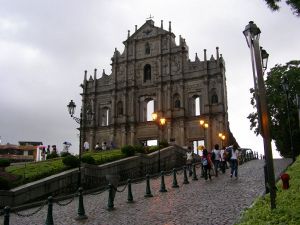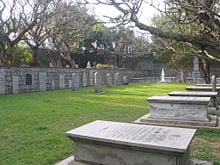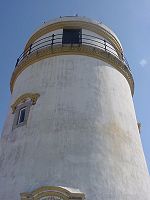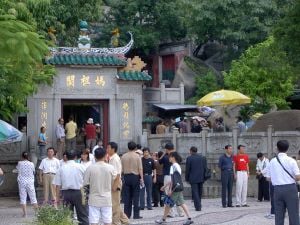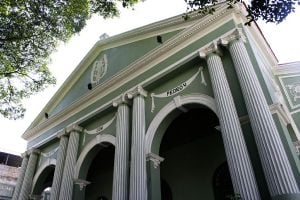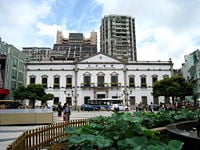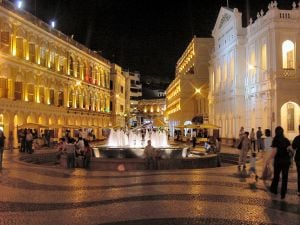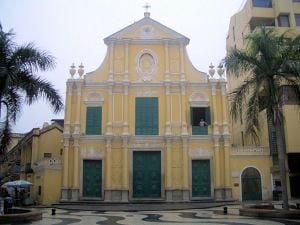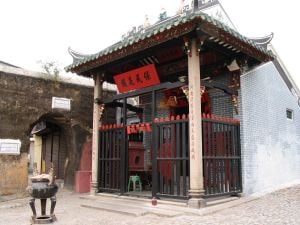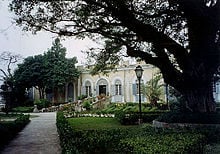Historic Center of Macau
| Historic Centre of Macao* | |
|---|---|
| UNESCO World Heritage Site | |
File:St paul's cathedral, macau.jpg Ruins of St. Paul's in Macau | |
| State Party | |
| Type | Cultural |
| Criteria | ii, iii, iv, vi |
| Reference | 1110 |
| Region** | Asia-Pacific |
| Inscription history | |
| Inscription | 2005 (29th Session) |
| * Name as inscribed on World Heritage List. ** Region as classified by UNESCO. | |
The Historic Center of Macau (Portuguese: O Centro Histórico de Macau; Traditional Chinese: 澳門歷史城區) denotes a collection of over twenty monuments and sites that witness the unique assimilation and co-existence of eastern and western cultures in Macau, a former Portuguese colony. It represents the architectural legacies of the city's cultural heritage, including monuments such as urban squares, stree tscapes, churches and temples. In 2005 UNESCO designated the Historic Center of Macau a World Heritage Site, the 31st designated World Heritage site in China.[1]
Sites
Ruins of St. Paul's
The Ruins of St. Paul's (Portuguese: Ruínas de São Paulo) refer to the façade of the Cathedral of St. Paul, a seventeenth century Portuguese cathedral in Macau dedicated to Saint Paul the Apostle. The ruins constitute one of Macau's most famous landmarks.[2]
Built from 1582 to 1602 by the Jesuits, the cathedral constituted the largest Catholic church in Asia at the time, and the royalty of Europe vied with each other to bestow upon the cathedral the best gifts. With the decline in importance of Macau, overtaken as the main port for the Pearl River Delta by Hong Kong, the cathedral's fortunes similarly ebbed. A fire during a typhoon destroyed it in 1835. The Fortaleza do Monte overlooks the ruin.
The ruins consist of the southern stone façade, intricately carved between 1620 and 1627 by Japanese Christians in exile from their homeland and local craftsmen under the direction of Italian Jesuit Carlo Spinola. The crypts of the Jesuits who established and maintained the Cathedral also remain. The façade sits on a small hill, with sixty six stone steps leading up to it. The carvings include Jesuit images with Asian themes, such as a woman stepping on a seven-headed hydra, described by Chinese characters as 'the Holy Mother tramples the heads of the dragon'.[3] A few of the other carvings include the founders of the Jesuit Order, the conquest of Death by Jesus, and at the very top, a dove with wings outstretched.
Resisting calls for demolition of the dangerously leaning structure, the Instituto Cultural de Macau excavated the ruins from 1990 to 1995 study its historic past. They uncovered the crypts and the foundations revealing the architectural plan of the building. They discovered numerous religious artifacts found together with the relics of the Japanese Christian martyrs and the monastic clergy, including the founder of the Jesuit college in Macau, Father Alessandro Valignano.[4] The Macanese government restored the ruins, turning the site into a museum. The facade has been buttressed with concrete and steel in a way which preserves the aesthetic integrity of the facade. A steel stairway allows tourists to climb up to the top of the facade from the rear. People customarily throw coins into the top window of the ruins from the stairs for luck.
Old Protestant Cemetery in Macau
The British East India Company established the Old Protestant Cemetery (Traditional Chinese: 基督教墳場; Simplified Chinese: 基督教坟场), located close to the Casa Garden, in 1821 in Macau in response to a lack of burial sites for Protestants in the Roman Catholic Portuguese colony.[5] The last resting place of the artist George Chinnery, missionaries Robert Morrison and Rev. Samuel Dyer, Royal Navy Captain Henry John Spencer-Churchill (son of the 5th Duke of Marlborough and great-great-grand-uncle of Winston Churchill) and US Naval Lieutenant Joseph Harod Adams (grandson of the second president of the United States, John Adams, and nephew of the sixth, John Quincy Adams).
The Portuguese Macau considered sacred Roman Catholic ground and the authorities barred the burial of Protestants within its city walls, while on the other side of the barrier gate, the Chinese proved as equally intolerant of the burial of foreigners in its soil. That left the Protestant community of British, American and Northern European traders, with the only option of a secret night-time burial in the land between the city walls and the barrier gate, and the risk of confrontation with Chinese should they be discovered, or worse, desecration of the grave once they had gone.
The matter finally resolved in 1821 after the death of Robert Morrison's wife, Mary, when the local committee of the East India Company voted to purchase a plot of land and resolve its legal status with the Portuguese such that the burial of Protestants would be permitted there. Later, the East India Company allowed burial of all foreigners, and moved several graves from other locations outside the city walls into the cemetery, explaining why some graves have dates before its founding in 1821. Britain, the United States of America, Holland, Denmark, Sweden and Germany have nationals buried there. The cemetery closed in 1858, after which referred to as the "Old" Protestant Cemetery. The Morrison Chapel, named in honor of Robert Morrison, adjoins the cemetery.
Guia Fortress
The Guia Fortress (Portuguese: Fortaleza da Guia; Chinese: 東望洋炮台), a historical military fort, chapel, and lighthouse complex, stands in the former Portuguese colony of Macau, in China. The fort and chapel had been constructed between 1622 and 1638, after an unsuccessful attempt by the Netherlands to capture Macau from Portugal.[6] The lighthouse had been constructed between 1864 and 1865, the first western style lighthouse in East Asia or on the China coast. The lighthouse stands at ninety one meters tall, and has a light visible for some twenty miles in clear weather conditions. The complex, built upon the highest point on Macau, Guia Hill, received its name from the same location. In 1998, builders uncovered frescoes in the chapel during routine conservation work, representing both western and Chinese themes.
A-Ma Temple
A-Ma Temple (Portuguese: Templo de A-Má;Traditional Chinese: 媽閣廟; Simplified Chinese: 妈阁庙), situated on the southwest tip of the Macau Peninsula, constitutes one of the oldest and most famous temples in Macau.[7] Built in 1488 C.E., the temple has been dedicated to the goddess of seafarers and fishermen Matsu.
The name Macau may have derived from the temple. When the Portuguese sailors landed at the coast just outside the temple, asking the name of the place, the natives replied "A-Ma-Gao" (Bay of A-Ma). The Portuguese then named the peninsula Macau.[8] Ancient Chinese texts describe the temple well, and paintings provide good depictions. The Temple stands as one of the first scenes photographed in China.
Dom Pedro V Theatre
Dom Pedro V Theatre (Traditional Chinese: 伯多祿五世劇院), situated at Largo de Santo Agostinho, Macau, had been one of the first western-style theaters in China. The theatre constitutes an important landmark in the region and remains a venue for important public events and celebrations. Local Portuguese built the Dom Pedro V Theatre in 1860 to commemorate their reigning king, Peter V. The theater, neo-classical in design, incorporated a portico front on a rectilinear plan.
Sir Robert Ho Tung Library
Sir Robert Ho Tung Library (Portuguese: Biblioteca Sir Robert Ho Tung; Traditional Chinese: 何東圖書館), a public library in Macau, China, sits in St. Augustine’s Square in the Historic Center of Macau. The library has been housed in a mansion that has good historical, cultural and architectural value.[9]
Dona Carolina Cunha owned the building constructed before 1894. Later Hong Kong businessman Sir Robert Ho Tung purchased the mansion in 1918 as a retreat and he lived there between 1941 and 1945. His will bequeathed the building to the Government for conversion to a public library when he passed away in 1955. Sir Robert Ho Tung Library formally opened in 1958 to the general public. In 2005, the government constructed a new building near the back garden of the mansion, making the library the biggest public library in Macau.
Leal Senado
The Leal Senado, Portuguese for Loyal Senate, served as the seat of Macau's government (Legislative Assembly of Macau) during its time as a Portuguese colony. Located at one end of the Senado Square, he building had been constructed in 1784. Portugal's Prince-Regent João, who would later become King John VI of Portugal, bestowed the titl on Macau's government in 1810 as a reward for Macau's loyalty to Portugal during the Iberian Union, between 1580 and 1640.
After the handover of Macau to China in 1999, it became the headquarters of the Institute of Civic & Municipal Affairs (Portuguese: Instituto para os Assuntos Cívicos e Municipais).
Senado Square
The Senado Square, or Senate Square (Portuguese: Largo do Senado; Traditional Chinese: 議事亭前地), designates a paved area in the center of the former Portuguese colony of Macau, enclosed by the building of the Leal Senado, the General Post Office, and St. Dominic’s Church.[10] The square has been paved in the traditional Portuguese pavement.
Holy House of Mercy
Holy House of Mercy (Portuguese: Santa Casa da Misericórdia; Traditional Chinese: 仁慈堂大樓), designates an historic white structure in Macau's Senado Square . Built in 1569 on the orders of the Bishop of Macao. The structure had been a medical clinic and several other social welfare structures in early Macau. It later served as an orphanage and refuge for widowers of sailors lost at sea.
St. Dominic's Church
St. Dominic's Church (Portuguese: Igreja de São Domingos; Traditional Chinese: 玫瑰堂), a Catholic church in the former Portuguese colony of Macau, stands in the Largo de São Domingos near Leal Senado. Currently (2008) the church has been used as a special administrative region in China. Three Spanish Dominican priests built the church in 1587. The the first Portuguese newspaper on Chinese soil , A Abelha da China (The China Bee), published from the building in 1822.
Na Tcha Temple
The Na Tcha Temple (Traditional Chinese: 大三巴哪吒廟), built in 1888, constitutes a Buddhist and Taoist temple in Macau dedicated to the worship of the deity Na Tcha. The small traditional Chinese temple comprises a simple, single chamber building measuring 8.4 meters (28 ft) long and 4.51 meters (14.8 ft) wide. The entrance porch opens to the temple building measuring 5 meters (16 ft) in depth. The building, painted gray, has few ornamentations, except for paintings on walls under the entrance porch. The Na Tcha Temple, located behind the Ruins of St. Paul's, remains of a principal Jesuit cathedral in the region, serving as one of the best examples of Macau's multicultural identity.
Fortaleza do Monte
Fortaleza do Monte (Portuguese for Mount Fortress, also Monte Forte, officially Fortaleza de Nossa Senhora do Monte de São Paulo, in English: Fortress of Our Lady of the Mount of St. Paul; Chinese: 大炮台) is the historical military centre of the former Portuguese colony of Macau, in the People's Republic of China. It is part of the "Historic Centre of Macau", a UNESCO World Heritage Site.
The fort was initially built in the 16th century for protecting the properties of Jesuit in Macau. Later it was seized by the Governor, for the defense of Macau.
The Museum of Macau was built on the hill in the 1990s. The tree covered park at the top of the fort has a panaromic view of the mainland area of Macau.
Casa Garden
Casa Garden is a small parkette located in Macau Peninsula, Macau. Built in 1770, the park was originally the residence of a wealthy Portuguese merchant Manuel Pereira. At a later period the it was rented out to the English East India Company and was used to house the directors of the Macau branch of the company. The park contains the old residence, Old Protestant Cemetery and an art gallery.
The place now is the headquarters of the Macau delegation of the Orient Foundation. In 2005, it was officially enlisted as part of the UNESCO World Heritage Site Historic Centre of Macau.
Other Sites
- Moorish Barracks
- Lilau Square
- Mandarin's House
- St. Lawrence's Church
- St. Joseph's Seminary and Church
- St. Augustine's Square
- St. Augustine's Church
- Sam Kai Vui Kun (Kuan Tai Temple)
- Cathedral of the Nativity of Our Lady of Macau|Cathedral of the Nativity of Our Lady
- Lou Kau Mansion
- City wall of Macau
- St. Anthony's Church
See also
- Religion in Macau
- Macau
- People's Republic of China
- Portuguese Empire
- Chinese Foreign Policy
- Guangzhou
Gallery
- Morrison chapel.jpg
Morrison Chapel in Old Protestant Cemetery
Notes
- ↑ Jo Allum, Sharon Leece, Christine Meaney, and Vivien Jones. 2006. Legends of the dragon: celebrating Asia's historic splendour (Hong Kong: PPP Co.), p. 68.
- ↑ Lindsay Ride, May Ride, and Jason Wordie. 1999. The voices of Macao stones (Hong Kong: Hong Kong University Press), p. xviii.
- ↑ Christina Miu Bing Cheng. 1999. Macau: A Cultural Janus (Hong Kong: Hong Kong University), p. 93.
- ↑ Steven K. Bailey. 2007. Strolling in macaul a visitor's guide to macau, taipa, and coloane ([S.l.]: Thingasian), p. 55.
- ↑ Lindsay Ride, May Ride, and Bernard Mellor. 1996. An East India company cemetery: protestant burials in Macao (Hong Kong: Hong Kong University Press), p. 275.
- ↑ Ride et. al., Macao stones, p. 77.
- ↑ Philippe Pons and Sarah Adams. 2002. Macao. Topographics (London: Reaktion), p. 73.
- ↑ Hakka and Macau (in Chinese). Retrieved 2008-08-05.
- ↑ Pons and Adams, Macao, p. 45.
- ↑ Cesar Guillen-Nuñez and Ka Tai Leong. 1999. Macao streets (Hong Kong: Oxford University Press), p. 17.
ReferencesISBN links support NWE through referral fees
- Allum, Jo, Sharon Leece, Christine Meaney, and Vivien Jones. 2006. Legends of the dragon: celebrating Asia's historic splendour. Hong Kong: PPP Co. ISBN 9789889889968.
- Bailey, Steven K. 2007. Strolling in macaul a visitor's guide to macau, taipa, and coloane. [S.l.]: Thingasian. ISBN 9780971594098.
- Cheng, Christina Miu Bing. 1999. Macau: A Cultural Janus. Hong Kong: Hong Kong University. ISBN 9789622094864.
- Guillen-Nuñez, Cesar, and Ka Tai Leong. 1999. Macao streets. Hong Kong: Oxford University Press. ISBN 9780195877663.
- Pons, Philippe, and Sarah Adams. 2002. Macao. Topographics. London: Reaktion. ISBN 9781861891365.
- Ride, Lindsay, May Ride, and Bernard Mellor. 1996. An East India company cemetery: protestant burials in Macao. Hong Kong: Hong Kong University Press. ISBN 9789622093843.
- Ride, Lindsay, May Ride, and Jason Wordie. 1999. The voices of Macao stones. Hong Kong: Hong Kong University Press. ISBN 9789622094871.
External links
- Official website. Retrieved August 7, 2008.
- Information from the website of UNESCO World Heritage Centre. Retrieved August 7, 2008.
- Information about the Morrison Chapel. Retrieved August 7, 2008.
- Report on the appointment of a new clergy-in-charge at the Morrison Chapel. Retrieved August 7, 2008.
- Ola Macau Guide entry on the Old Protestant Cemetery
- English site for Macau Heritage. Retrieved August 7, 2008.
- Ola Macau Guide-entry on the Leal Senado building. Retrieved August 7, 2008.
- Holy House of Mercy, Information from Macau Government Tourist Office. Retrieved August 7, 2008.
| |||||||
Credits
New World Encyclopedia writers and editors rewrote and completed the Wikipedia article in accordance with New World Encyclopedia standards. This article abides by terms of the Creative Commons CC-by-sa 3.0 License (CC-by-sa), which may be used and disseminated with proper attribution. Credit is due under the terms of this license that can reference both the New World Encyclopedia contributors and the selfless volunteer contributors of the Wikimedia Foundation. To cite this article click here for a list of acceptable citing formats.The history of earlier contributions by wikipedians is accessible to researchers here:
- Historic_Centre_of_Macau history
- Ruins_of_St._Paul's history
- Old_Protestant_Cemetery_in_Macau history
- Guia_Fortress history
- A-Ma_Temple history
- Dom_Pedro_V_Theatre history
- Sir_Robert_Ho_Tung_Library history
- Leal_Senado history
- Senado_Square history
- St._Dominic's_Church history
- Na_Tcha_Temple history
- Fortaleza_do_Monte history
- Casa_Garden history
The history of this article since it was imported to New World Encyclopedia:
Note: Some restrictions may apply to use of individual images which are separately licensed.
